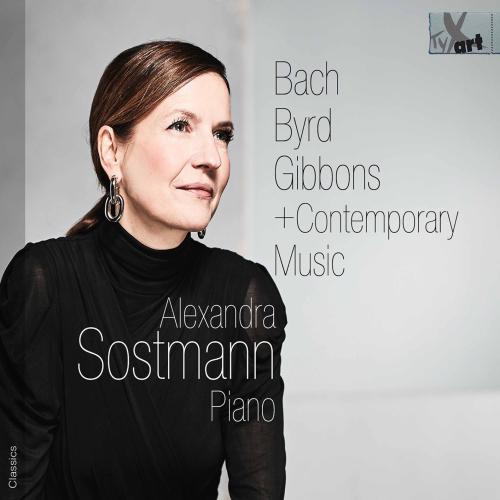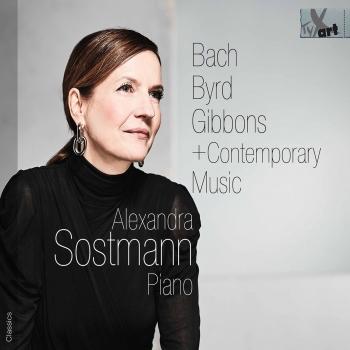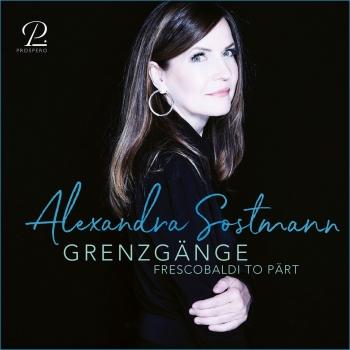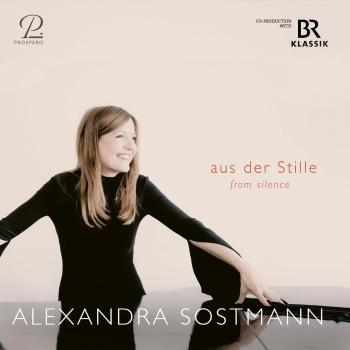
Bach, Byrd, Gibbons & Contemporary Music Alexandra Sostmann
Album info
Album-Release:
2020
HRA-Release:
19.06.2020
Label: TYXArt
Genre: Classical
Subgenre: Instrumental
Artist: Alexandra Sostmann
Composer: Johann Sebastian Bach (1685-1750), Oliver Knussen (1952-2018), John Tavener (1944-2013), William Byrd (1543-1623), Markus Horn (1972), John Adams (1947), Orlando Gibbons (1583-1625), Xiaoyong Chen (1955)
Album including Album cover
- Johann Sebastian Bach (1685 - 1750): Musikalisches Opfer, Op. 6, BWV 1079:
- 1 Musikalisches Opfer, Op. 6, BWV 1079: Ricercar à 3 06:10
- Oliver Knussen (1952 - 2018):
- 2 Prayer Bell Sketch, Op. 29 04:54
- Sir John Tavener (1944 - 2013):
- 3 The Lord’s Prayer 02:40
- William Byrd (1543 - 1623):
- 4 Pavana in D Minor, FVB 254 03:49
- 5 Galiarda in D Minor, FVB 255 01:23
- Markus Horn (b. 1972):
- 6 Piece After Byrd 08:49
- Sir John Tavener:
- 7 In Memory of Two Cats 01:45
- John Adams (b. 1947):
- 8 China Gates 04:41
- Orlando Gibbons (1583 - 1625):
- 9 Pavan, MB 18 "Lord Salisbury" 02:53
- 10 Galliard, MB 19 "Lord Salisbury" 01:53
- Sir John Tavener:
- 11 Zodiacs 02:03
- Xiaoyong Chen (b. 1955):
- 12 Diary VI: I. Prism 01:52
- 13 Diary VI: II. Swishing 01:25
- 14 Diary VI: III. Reflection 01:52
- 15 Diary VI: IV. Echo 01:52
- Johann Sebastian Bach: Musikalisches Opfer, Op. 6, BWV 1079:
- 16 Musikalisches Opfer, Op. 6, BWV 1079: Ricercar à 6 08:40
Info for Bach, Byrd, Gibbons & Contemporary Music
This new recording is about polyphonic references between the great counterpoint artists Byrd, Gibbons, Bach and the contemporary composers John Tavener, Oliver Knussen, John Adams, Markus Horn and Xiaoyong Chen. The two Bach Ricercari from the Musical Offering form the bracket. The exciting connection of the individual, different works to each other is created by the polyphonic structures, the modal church keys or by religious, spiritual references. 429 years lie between the work of Byrd and the work of Xiaoyong Chen composed for the release. With Bach, Byrd, Gibbons and Contemporary Music, the listener can expect a recording that is wonderfully audible, in a positive sense unexhausting. You have to get involved with the depth, the space and sometimes the silence, but it is worth it, because the music changes your own self and focuses attention on you. Im interested in the connections between different epochs and their polyphonic structures. So obviously there was no way that I could ignore Johann Sebastian Bach. However, I considered what to combine with his Ricercares a 3 and a 6 from The Musical Offering. First I thought of William Byrd, as I knew that polyphony and contrapuntal style were important to him, despite the fact that he was almost 150 years older than Bach. I began with vocal polyphony and arrived at Orlando Gibbons and virginal music, which I wanted to combine with contemporary music. And then the search began (Alexandra Sostmann)
Alexandra Sostmann, piano
Alexandra Sostmann
The pianist Alexandra Sostmann ranks among the select circle of musicians whose repertoire represents such an extraordinarily broad stylistic spectrum that ranges from Baroque to Modern. Effortlessly, fluently, she explores the intricately interwoven paths of musical history – in concert or on her CDs. In 2014, her solo album “Bach & Contemporary Music” was released. Her intelligent, sensitive interpretations of works from Bach to Xiaoyong Chen delight critics and the public alike.
Her latest CD, once again produced with the exclusive label TYXart, has been on the market since the late summer of 2017. In this solo album, Sostmann devotes herself to Johann Sebastian Bach and Frédéric Chopin and opens up a fascinating view of the artistic relationship between these two composers who, at first glance, appear so different. One link is the dance element that Sostmann brings to life with her subtle interpretations of selected Bach Suites and Chopin Mazurkas. The reviewers are once again highly impressed by this CD project, both regarding the conceptual idea and its implementation. “What does Bach sound like after you have been listening to Chopin? And what does Chopin sound like after you have been listening to Bach? Listening to the new CD of the pianist Alexandra Sostmann, you can engage in this experiment. She combines in a striking manner French Suites by Bach with Chopin’s Mazurkas – remarkable” (NDR Kultur, Germany, 24.09.2017). In his observations Frank Siebert of “FonoForum” emphasizes Sostmann’s special ability to bring to life the interior cosmos of the Suites and Mazurkas with masterful serenity, and thus, “far removed from any ostentation, to cautiously unlock the poetic interiors of the various pieces.” Jan Brachmann from FAZ is fascinated by Sostmann’s rising to an exuberant, elegant enthusiasm: “She manages to fully transfer the bright, silvery flow of the harpsichord’s timbre to today’s piano, ornamenting the repetitions so elegantly and joyfully that it’s fun to spot all those snub-nosed trills, freckly mordents and curly slides between the artfully interlaced garlands of Bach’s dances.” Hardly surprising, then, that the critics of the Tagesspiegel have rated the solo album as one of the best CDs of the autumn 2017 and Lufthansa has chosen Sostmann’s Bach and Chopin interpretations for its flight programme. Sostmann will record a new CD in 2019 and, in accordance with her artistic mission, draw attention to exciting links in music history.
Alexandra Sostmann studied with Professor Volker Banfield and the celebrated Bach interpreter Professor Evgeni Koroliov at the Hamburg University of Music and Theatre and with Dr Peter Katin at the Royal College of Music in London, where she gained her concert diploma. She rounded off her musical studies with semesters abroad at the Mozarteum in Salzburg and at the Ecole Normale de Musique de Paris Alfred Cortot. One of her teachers in Paris was Marcella Crudeli. While still a student, Alexandra Sostmann won the 1st prize in the Caltanissetta International Chamber Music Competition (1998). This was followed by further accolades in international piano and chamber music competitions.
Alexandra Sostmann performs both as soloist and chamber musician in notable German concert halls (e.g. Konzerthaus Berlin, Frauenkirche Dresden, Laeiszhalle Hamburg) as well as internationally, in Rome, Vienna, Zurich, London, Paris, Amsterdam, Lisbon, in South America, the USA and Canada. Among the many orchestras accompanying her are Göttingen Sinfonieorchester, Kammersymphonie Berlin, Deutsches Filmorchester Babelsberg, Cappella Istropolitana, Orquesta Sinfónica de Bahía Blanca, and Banda Sinfónica Municipal de Mar del Plata, Argentina. Apart from her solo and orchestral concerts, she passes on her knowledge and expertise in the context of master classes.
Her performances at both internationally renowned and small but exquisite music festivals meet with much acclaim. These include the Schleswig-Holstein Music Festival, the Ruhr Piano Festival, the Festival d’Ile de France, the Central European Festival at Žilina, Slovakia, the Swiss piano festival “Klavierissimo”, and the “Sunnisheimer Klaviertage” in Sinsheim, Germany.
For over 10 years, Alexandra Sostmann has been performing in the internationally successful Duo Villarceaux devoted to piano music for two pianos and for four hands. As in her solo career, her artistic work covers an extremely broad stylistic spectrum. Thus the duo’s repertoire comprises famous compositions for two pianos from the Baroque, Classical and Romantic periods as well as rarely performed modern works and diverse first performances. Besides radio and TV recordings, “Duo Villarceaux” has published several CDs on the Thorofon, Phoenix Edition und TYXart labels with works by Ravel, Debussy, Stravinsky, Rachmaninoff, Piazzolla, Bach and contemporary music. Its CD of Stravinsky’s “Le Sacre du Printemps” met with huge international acclaim. The reviewer of the “American Record Guide” enthused: “… the two young German pianists are excellent – I’ve rarely heard better unison playing or greater understanding of the Stravinsky idiom.” Since the spring of 2015, Sostmann has been playing regularly in South America. Her first concerts on the South American continent led directly to further engagements. Thus, in the autumn of 2016, she performed at several orchestral concerts in Argentina, including Stravinsky’s Concerto for Piano and Wind Instruments, which she played, among other concert halls, at the well-known coastal town of Mar del Plata. The public and critics were enthusiastic: “… this music was a gift of God …” (“La Capital”, Mar del Plata). In Mar del Plata, Sostmann was officially awarded the status of a “Guest of Honour”, and in the autumn of 2017, she gave a master class there as well as two orchestral concerts (Teatro Colon) of Mozart’s piano concerto KV 466 and Ravel’s Piano Concerto for the Left Hand. In 2018, Sostmann again travelled Argentina with a Mozart programme and continued her successful collaboration with the Sinfónica de Bahía Blanca. She will be touring in the spring of 2019, giving solo recitals in Cordoba and the Teatro Colon among other things. In the autumn she is playing Rachmaninov’s Piano Concerto No. 2 in Cuenca, Ecuador’s UNESCO World Heritage Site.
Alexandra Sostmann is keen to work with composers and artists from other disciplines such as the choreographer and ballet director Jutta Ebenother and the Nordhausen Company in the production of "La dame aux Camélias". As ballet music for her version of the world-famous love story, Ebenother had chosen works by Chopin and Liszt, which Alexandra Sostmann interpreted on the piano live on stage. She can also be heard as a Lieder accompanist with various programmes, such as “Die Winterreise”. The composers with whom she works closely include the internationally renowned Chinese composer Xiaoyong Chen and the jazz pianist and composer Markus Horn, who lectures at Hannover University of Music, Drama and Media.
This album contains no booklet.

















